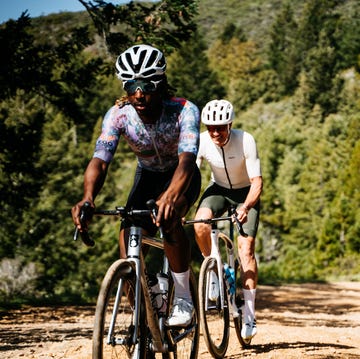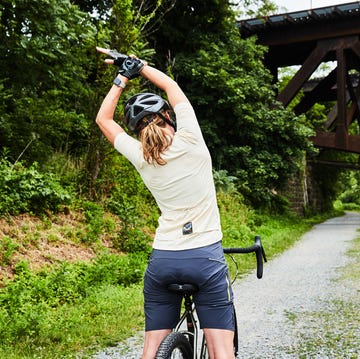The way you position yourself on your bike might seem so simple, you don’t give it a second thought. But optimal posture while you cycle isn’t always intuitive—and can fall by the wayside when you’re out for long rides.
When you start experiencing posture fatigue, it can quickly snowball into other issues, from aches and pains to a less forceful pedal stroke. Here’s what you need to know about what causes this, plus tips to help combat fatigue and perfect your posture both on the bike and throughout the rest of your day.
What is posture fatigue?
“Posture fatigue is a lack of endurance in your stabilizer muscles through your upper back and your core, which is very common if you’re not training those stabilizers,” says Brian Gurney, DPT, C.S.C.S., a trainer, board-certified sports clinical specialist, and physical therapist at BeFit Therapy in New York City. “A lot of times endurance athletes spend so much time on the bike, but they don’t complement it with the necessary strengthening work. Then people run into problems because the muscles get tired while they’re riding.”
Once those muscles get tired as you cycle, others take over—which can wind up totally throwing off your position. For example, says Gurney, when stabilizing muscles including the serratus anterior muscle (which connects your shoulder blades to the rib cage) and scapular muscles (which support your shoulder joints) are fatigued, the trapezius muscles (upper back) usually overcompensate.
Instead of riding with an optimal posture with a neutral spine, relaxed shoulders, and slightly bent elbows, those dominant traps can cause your shoulders to stiffen and shrug upward. That not only puts more strain on your neck but can also affect everything down to the way you pedal, he says.
What issues can posture fatigue cause for cyclists?
Imperfect posture can cause a lot of problems with your mechanics. First of all, you’ll be less stable on your bike, says Gurney, especially if you’re lacking the core stability required to keep you upright. “There’ll be more side-to-side movement as you’re pedaling, especially when your core gets tired, to try to drive your legs,” he explains. “If you’re not stabilizing through your core, you’re also going to lose power through your legs. You’re going to start to lose efficiency of your stroke.”
Another way bad posture can zap your efficiency: It lowers your breathing capacity, says Gurney. Those overworked trapezius muscles and hunched posture can cause you to breathe more shallowly, limiting your breaths to your chest or neck.
That compounds your issues, he says, because the overworked trapezius plus breathing that’s limited to your chest or upper back tend to result in tight muscle knots throughout the neck and shoulders. That, along with the extra pressure on your neck from your hunched posture, can leave you with serious neck pain.
This kind of modified posture can extend over into your life off the bike, too. Cyclists who pushed their chin forward, flexed their elbows, and shrugged their shoulders to compensate for weaknesses experienced repetitive stress and microtraumas in the scapula during long-distance rides, resulting in ongoing pain, according to a a 2010 article published in the British Journal of Sports Medicine.
How do you combat posture fatigue?
Pay attention to your posture all day
A less-than-ideal posture off the bike is common for cyclists, even more so in those whose handlebars are lower and farther from their saddle, found a 2023 systematic review in Sports Biomechanics; cyclists demonstrated more lumbar kyphosis and thoracic flexion (rounding of the back) compared with non-cyclists, and the effect was more prominent as their time on the bike increased.
To help counteract this, make a point to become more conscious about how you sit and stand at all times—while you’re riding your bike, walking on your commute, or just sitting on the couch.
That’s especially important when you’re working, if you have a desk job. “Be aware of your head posture when you’re looking at your computer screen—use your eyes, not your head,” advises Gurney. “We all fall into that trap where we let ourselves fall in toward the screen. If you need to make the screen bigger, make it bigger so you don’t need to do that.”
Take breaks
Anytime when you’re sitting for long periods, set a timer to remind yourself to stand every half hour or so. Gurney recommends breaking for a little stretching, like standing in a doorway and gently pressing an arm against each side of the frame to open up your chest.
Get fit
Make sure to get a proper bike fitting if you haven’t (or haven’t in a long time). Slight adjustments in knee and trunk flexion led to significant effects on comfort, fatigue, and pain in a 2017 study from Spain. Researchers emphasized how important adjustments to find the right fit personalized to your body is important for being able to maintain the most beneficial posture to boost performance and avoid injury.
Do the right moves
Strength training is super important for improving your posture, both on and off the bike. You don’t want to ignore doing certain exercises with a higher load and lower reps because those are needed to build strength, says Gurney—but focusing on training for muscular endurance (that means low weight, higher reps, short rest periods) is key when you’re riding your bike for extended durations. And it’s especially crucial for your posture-supporting muscles when you want to beat fatigue.
Here are the exercises and stretches Gurney recommends to strengthen your core and upper-back stabilizers and open up your chest.
1. Bear Crawl
Why it works: This is one of Gurney’s favorites for firing up the entire body. It’s a closed-chain core exercise, he says, meaning your hands and feet are both touching the ground as you work. “These are really effective for getting the whole body—your upper back, shoulder, core, and legs—to work together,” just as you need on the bike.
How to do it:
- Start on all fours with feet flexed and toes against floor, shoulders over wrists and knees under hips.
- Press toes and hands evenly into floor and lift knees an inch or two.
- Staying close to floor, move right hand and left foot forward, then repeat on opposite side.
- Continue alternating sides to crawl across floor for 45-60 seconds.
2. Plank Shoulder Tap
Why it works:A variation on a traditional plank, this is another move that engages your entire body while firing up your core and challenging your stability.
How to do it:
- Start in plank position with body in a straight line from shoulders to feet.
- Slowly lift right hand and cross chest to tap left shoulder.
- Lower hand to floor, and repeat on opposite side for 1 rep.
- Continue alternating for 12-15 reps.
3. Y-W-T Raise
Why it works: This exercise strengthens your deltoids and the stabilizers around your shoulders.
How to do it:
- Lie facedown on the floor, arms and legs extended, with arms extended overhead into a Y shape.
- Squeeze shoulder blades together and engaging core, lift upper body as high as possible, maintaining the Y position, and hold for a few seconds.
- Lower back down and bring elbows toward sides to form a W shape.
- Engaging core, lift upper body as high as possible, maintaining the W position, and hold for a few seconds.
- Lower back down and extend arms out to sides to form a T shape.
- Engaging core, lift upper body as high as possible, maintaining the T position, and hold for a few seconds.
- Lower back down. That’s 1 reps.
- Repeat for 12-15 reps.
4. Wheel Pose
Why it works: “When you’re sitting, you can become like a T-rex; wheel pose flips that around in the opposite direction and opens everything up, from your chest to your hip flexors,” says Gurney. As isometric exercise (meaning you hold still in the position), it also strengthens your shoulders, upper back, hamstrings, and glutes while you’re getting that great front-body stretch.
How to do it:
- Lie faceup, knees bent and feet on floor.
- Place palms on floor by ears, fingers pointing toward shoulders.
- Press into feet and lift hips up, pressing into hands to bring crown of head to floor.
- Pressing into feet and hands equally, straighten arms and lift head off floor.
- Hold for 30 seconds, then repeat 3 times.
5. Thoracic Extension
Why it works: Gurney recommends this easier, gentler back bend if you’re not quite able to do wheel pose. You can progress from here to a supported wheel pose with a small physio ball under your back.
How to do it:
- Sit on floor with knees bent, and place a foam roller under upper back. This is the starting position.
- Place hands behind head, then slowly lower head and shoulders over the roller.
- Lift back up to start.
- Repeat for 5-10 reps.
- Roll slightly up or down the roller and repeat, avoiding the lower back.



















